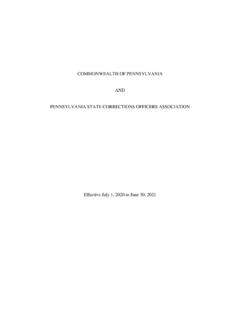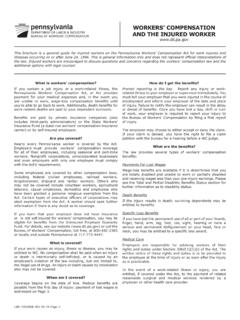Transcription of Practical guidance at Lexis Practice Advisor
1 1 Practical guidance at Lexis Practice Advisor Lexis Practice Advisor offers beginning-to-end Practical guidance to support attorneys work in specific legal Practice areas. Grounded in the real-world experience of expert practitioner-authors, our guidance ranges from Practice notes and legal analysis to checklists and annotated forms. In addition, Lexis Practice Advisor provides everything you need to advise clients and draft your work product in 14 different Practice areas. Taxation and Reporting of Settlement payments for Employment-Related Lawsuits by William Hays Weissman, Littler Mendelson, This Practice note outlines the most common tax and reporting issues associated with the settlement of employment-related litigation. The proliferation of employment-related litigation over the last decade has led to a significant numbers of settlements. Attorneys often overlook or fail to address the tax consequences of such litigation until after the parties reach a settlement, leading to potential issues for both the employer and employee.
2 We address the following issues to help you properly handle tax and reporting issues related to settlements of employment-related claims: Key steps for determining taxation and reporting of settlement payments Taxation and reporting of wages Taxation and reporting of non- wage payments IRS chart showing taxation and reporting requirements for various types of payments Unique issues concerning taxation and reporting of attorney s fees IRS charts showing taxation and reporting requirements for attorney s fees Tax consequences of settlement allocations guidance for pushing back on opposing counsel who request and/or demand improper settlement allocations Key Steps for Determining Taxation and Reporting of Settlement payments The IRS has laid out four key steps for determining taxation and reporting requirements for settlements. See PMTA 2009-035 (Oct. 22, 2008). We address each of these steps in turn. Step 1: Identify the Character of the Payment and Nature of the Claim The character of the payment is the type of payment being made to address the particular claims at issue.
3 A payment may be characterized as severance pay, front pay, back pay, compensatory damages, liquidated damages, consequential damages, or restoration of benefits. Note that for tax purposes the labels that the parties place on payments do not determine the character of the payment. Treas. Reg. (a)1(c); (b)(1)(c); 3401(a)1(a)(2). Thus, just calling something compensatory or non- wages damages in a settlement agreement will not be determinative of the payment s character for tax purposes. Step 2: Determine Whether the Payment Is Taxable Whether a payment is taxable depends both on its character and the nature of the claim. For example, payments made on account of a personal physical injury do not constitute income and thus are not taxable. 104(a)(2). Also, certain causes of action limit the types of damages plaintiffs may receive. For instance, the Age Discrimination in Employment Act (ADEA) does not permit tort type damages; thus, the parties should not allocate any amounts of a settlement of an ADEA claim for personal physical injury.
4 Comm r v. Schleier, 515 323 (1995). Step 3: Determine Whether the Payment Constitutes Wages Assuming the payment is income, the next question is what kind of income it is: wages or non-wages. From the perspective of the payor of a settlement that includes wages, such payments are subject to more requirements than non-wages. 2 Practical guidance at Lexis Practice Advisor We provide more detail on tax and reporting requirements for both wage and non- wage payments in the sections below entitled Taxation and Reporting of Wages and Taxation and Reporting of Non- wage payments . Step 4: Determine the Proper Reporting for Attorney s Fees In general, attorney s fees are income to both the party receiving payment and the attorney receiving payment. Further, there are issues relating to whether the recipients of such income are entitled to deductions for paying attorney s fees, and the proper reporting of such fees. We provide more detail on tax and reporting requirements for attorney s fees payments in the section below entitled Unique Issues Concerning Taxation and Reporting of Attorney s Fees.
5 Taxation and Reporting of Wages When a payment is treated as wages, it is generally subject to federal and state income tax withholding (if the applicable state has an income tax), Social Security taxes, Medicare taxes, federal and state unemployment taxes, and any other state employment taxes, such as disability insurance taxes. The wages and withholdings are reported on IRS Form W-2. All payments of wages are treated as wages subject to employment taxes unless specifically exempted. Courts and taxing agencies classify severance pay as wages. As explained in more detail below, with limited exceptions, courts and taxing agencies also classify back pay and front pay damages as wages. Below we also discuss the inconsistent classification of amounts paid under the Family and Medical Leave Act (FMLA) and payments pursuant to claims based on failure or refusal to hire. Back Pay Back pay is compensation that constitutes the difference between the pay the employee received and the pay to which the employee was legally entitled to receive up to the time of the settlement date.
6 No statute or regulation exempts back pay from the definition of wages for tax purposes. 3401; United States v. Cleveland Indians Baseball Co., 532 200 (2001). This is true even if the workers receiving the payments are no longer employed by the payor for other purposes at the time the payment is made. Treas. Reg. (a)-1(a)(5). The Supreme Court has held that back pay awarded under the National Labor Relations Act to an employee whose employer had wrongfully discharged him was wages under the Social Security Act. Social Security Bd. v. Nierotko, 327 348 (1946). The Court stated that the back pay constituted remuneration and also held that the remuneration was for employment even though the back pay related to a period during which the petitioner did not perform any service. Nierotko, 327 at 365 66. Several courts dealing with whether payments upon settlement of claims constituted wages for employment tax purposes have cited Nierotko.
7 See, , Mayberry v. United States, 151 855 (8th Cir. 1998); Hemelt v. United States, 122 204 (4th Cir. 1997). The exception to the general rule that back pay constitutes wages is when the employee receives back pay on account of a personal physical injury or illness. See, , Johnson v. United States, 76 Fed. Appx. 873 (10th Cir. 2003). Front Pay Front pay is compensation for an employee that he or she would have received after the settlement date had the employer not allegedly engaged in prohibited conduct ( , future lost earnings). Front pay has been subject to less litigation than back pay. Nonetheless, the limited authority appears to support treating front pay as wages. For example, a federal district court in New Jersey held that both back pay and front pay paid as part of a settlement award to a former employee were wages and thus subject to federal employment taxes. Josifovich v. Secure Computing Corp., 2009 Dist. Lexis 67092 ( July 31, 2009).
8 The court found that because the Supreme Court in Nierotko held that services performed a component of the definition of wages, which are subject to withholding encompasses the entire employee-employer relationship and not merely the work actually performed, this Court concludes that front pay, like back pay, is subject to withholding taxes. Josifovich, 2009 Dist. Lexis 67092, at *12 13. However, the Fifth Circuit ruled that front pay is not wages because it represents a loss in earning capacity, not for services already performed. Dotson v. United States, 87 682, 690 (5th Cir. 1996). Thus, courts are not entirely consistent in their treatment of front pay. However, outside the Fifth Circuit, it would not be advisable to treat front pay as other than wages for tax purposes. Amounts Paid under the Family and Medical Leave Act (FMLA) Courts and taxing agencies generally treat amounts paid under the Family and Medical Leave Act (FMLA) as wages.
9 However, courts in the Eastern District of Pennsylvania have held that based on the peculiar language of the FMLA which creates a remedy of damages equal to the amount of denied or lost wages (see 29 2617(a)) amounts paid under the FMLA are not for services 3 Practical guidance at Lexis Practice Advisor in employment but rather for damages that are simply equivalent to the amount of denied or lost wages, and as such are not themselves wages for tax purposes. Carr v. Fresenius Med. Care, 2006 Dist. Lexis 29627, at *8 ( Pa. 2006); Churchill v. Star Enterprises, 3 F. Supp. 2d 622 ( Pa. 1998). The IRS, however, does not appear to subscribe to this view. Thus, the IRS generally will consider amounts paid under the FMLA as wages for tax purposes. Refusal to Hire Cases The IRS has stated that claims based on failure or refusal to hire are back pay and thus wages. Rev. Rul. 78-176. A federal district court in the Southern District of New York cited Rev.
10 Rul. 78-176 with approval in Melani v. Board of Higher Ed., 652 F. Supp. 43 ( 1986), aff d, 814 653 (2d Cir. 1987). However, the Eighth Circuit has held differently, finding that Federal Insurance Contributions Act (FICA) tax ( , federal payroll tax) and income tax withholding do not apply unless an actual employer-employee relationship existed, and no such relationship existed when an employer failed to hire an individual. Newhouse v. McCormack, 157 582 (8th Cir. 1998). Parties that settle failure to hire claims in the Eighth Circuit may treat the settlement as other than wages; otherwise, the IRS would likely take the position that the parties should allocate the settlement to wages. Taxation and Reporting of Non- wage payments Unlike wages, non- wage payments are not subject to tax withholding by an employer, although they are usually income to the recipient, and thus taxable for income tax purposes. If the amount paid is $600 or more, the employer must report the amount on IRS Form 1099-MISC, in box 3.














